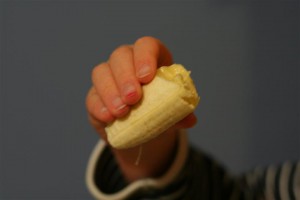Today I tried something different. I made up a weekly practice log that lists all the things we need to practice during the week. I set my own arbitrary parameters — e.g., we will practice two review songs a day and will practice all of them in the course of the week. (You can see a blank log on Scribd.com.)
Within those parameters, though, I let M pick what to do. And each time we completed something, I gave her a blank playing card whose back she can color (I will write the names of practice activities on the front so we can use the cards in future lessons).
After our lesson, which took a little over an hour (note: she didn’t have hands on the instrument all that time), I was telling my wife about the new chart and that the lesson went well. In the background, M chimed in:
I liked doing it.
So for today at least, I found the holy grail: a productive practice that M enjoyed.
We did:
- Targeted, repeated listening of Meadow Minuet to learn the notes and the structure.
- For structure, we counted groups of eight measures and said A, B, C, or D at the beginning of each group of eight measures.
- For notes, we sang the melody.
- Practiced the C section of Meadow Minuet once I knew M could sing it. I played the bass notes.
- With Steady Hands — played through once or twice, but because M still has trouble knowing when she’s at the end, we played alternating sections: B1 (me), B2 (her), A1 (me), A2 (her), B1 (me), B2 (her), A1 (me), A2 (her). This way, she was responsible for knowing when the piece ended. It seemed to help.
- French Folk Song — played through once, but then focused on two 4-bar sections, B and E. We played themrepeatedly with the metronome and gradually increased it to 176 bpm. M still played with ease at this tempo.
- Allegretto — played through a couple of times.
- M conducted me playing Lightly Row and Aunt Rhody while she sang the note names. Flawless.
- G scale — played a few times.
When we went over the practice log before starting, M added a practice item to our choices by writing on the page: “Make up song.” Then she wrote a song name with arbitrary German letters. Today’s completed log, with M’s annotations:
Suzuki guitar book 1 practice log – first draft, filled out
